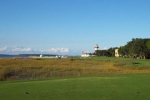By Jeffrey A. Rendall, Photos By Aaron Frey
SPOTSYLVANIA, VA – Ecosystems, and golf.
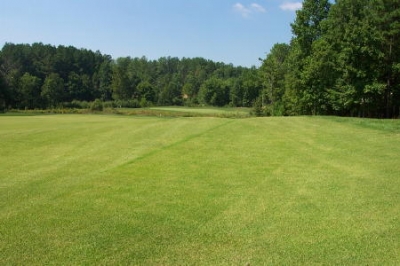 |
| The view from the second fairway. A lush green carpet to play on. |
Usually, when you're talking about the latter and the former together, you've got people talking about how one destroys the other. Environmental preservationists often see the reformation of previously undeveloped land as permanently harmful to any particular ecosystem; but that's only a small part of the picture, especially these days, when rigid rules govern the planning and construction of golf courses.
Could it be that bringing the game of golf to a piece of property can actually benefit the acreage?
Yes, if you're talking about Fawn Lake Golf & Country Club. Fawn Lake is a private club, located just down the road from the Wilderness National Battlefield (about 15 minutes west of Fredericksburg). For Civil War buffs, this area is significant for history as well as beauty, and for golf nuts, Fawn Lake's a haven for great golf as well as natural splendor.
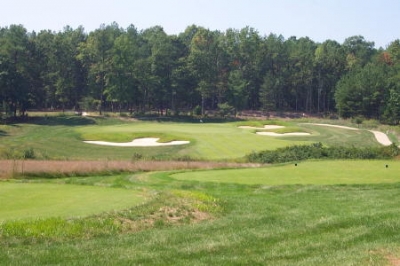 |
| Hit it high and straight to the 4th green, or trouble comes your way. |
Vicki Martz, Vice President and Director of Environmental Design at Palmer Course Design (Project Architect at Fawn Lake), says building the golf course was actually like constructing an ecosystem: "The biggest issue at Fawn Lake was to recreate a natural ecosystem there. Most people that go to Fawn Lake won't realize that those environmental wetlands haven't always been there. There was a huge amount of time, money and effort spent in native, natural landscaping all around the course, and that's the hallmark when you look at Fawn Lake."
According to Martz, Fawn Lake was the largest mitigation project in the Commonwealth of Virginia, other than projects conducted by VDOT. "Mitigation" meaning the replacement or enhancement of environmentally protected jurisdictional areas. In other words, if you've got land coming under federal authority, you can't just run a dozer over it. It's got to be accounted for.
"We began the project in the late 80's, routing the course over the low lying areas in order to preserve the higher ground for houses and the development. We subsequently learned that we impacted environmental areas (even though they didn't look like wetlands), so not only did we have to leave those areas alone, we had to create more," Martz said.
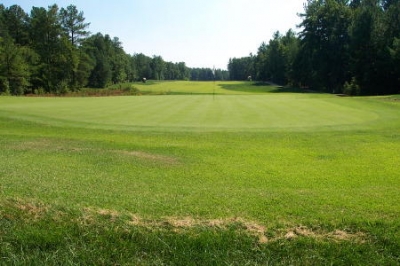 |
| Glancing back from the 5th green, you'll see the parkland nature of Fawn Lake. |
She continues, "Mitigation is a huge issue for all of golf course construction these days. Because the smallest little swale or low area, depression of ground can be deemed impacted. We've even discovered that there have been low areas from tractor ruts in a field, and the ruts therefore held water, and different vegetation came in and was considered jurisdictional."
Wow. This is serious business.
Martz said that the original plan was disregarded in favor of a new one, incorporating the mandates of the various governmental agencies. "There are a lot of holes that play across the wetlands. Those wetlands weren't necessarily there -- they were part of the mitigation that we went in and either recreated or enhanced. And everything on the course draining to those wetlands had to have what are called 'Sandy Filtering Swales.'"
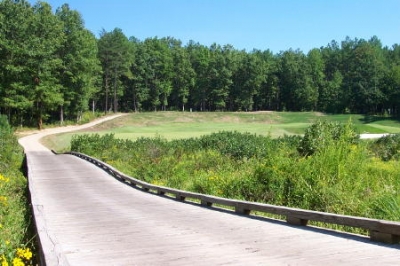 |
| A bridge spans the wetlands to take you to the 7th green - hope your golf ball gets there first. |
"So you'll see big long strips of what looks like big bunkers, where any runoff from the fairways would flow into these and cleanse before it gets to the runoff areas. You'll see a lot of this type of thing on par threes, some on par fours – and people will say, 'gee, that's an awfully demanding shot,' but it was really difficult to get that golf course in there," Martz added.
We're glad they did, because Fawn Lake is a terrific golf experience. As Martz alluded to, there are some sizeable environmental areas, but there are also the more 'friendly' Palmer Design characteristics, namely extremely wide landing areas, large greens, and overall fair challenge.
But it's got even more than that. Chad Maes, Assistant Golf Professional at Fawn Lake, says a lot of the club's quality is intangible: "I always get a good feeling about Fawn Lake, because there's always something happening out on the golf course to give you a sense of belonging. For me, it's a family of deer that's grown to about 20, and the little ones will run away, but the big ones will come right up to you and almost eat right out of your hands."
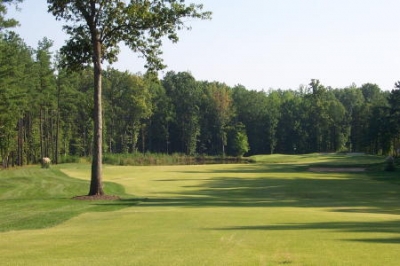 |
| The par five 16th (568 yards) seems like it goes on forever, but it's a nice journey. |
"It's a feeling that when you're at Fawn Lake, you don't hear cars driving by, you don't hear horns honking, you don't hear any of the 'city' sounds, other than the sounds of being with your friends and your family on the golf course. It's you and the golf course and nature, and that's what I think of when I consider Fawn Lake," Maes said.
It is quiet. Noticeably so. And part of that is the course doesn't get much golf 'traffic,' either. Maes elaborates: "On a typical weekday, we'll do something like 40 to 50 rounds a day, maybe double that on the weekends. It helps to keep things moving along, but also to maintain the golf course. We've got Zoysia tees and fairways, and it's a perfect playing surface for this type of course and location -- our club's almost always in great shape. Our superintendent, Dave Smith, does a fantastic job with what he has here."
Fawn Lake is a gated community, which helps keep down outside automobile traffic. There are houses bordering some of the fairways, but the setbacks are extremely large, just like the landing areas. When you combine the quality of the golf course, the views of the lake, and the peacefulness of the private community, it's a great place. Wouldn't mind living there myself!
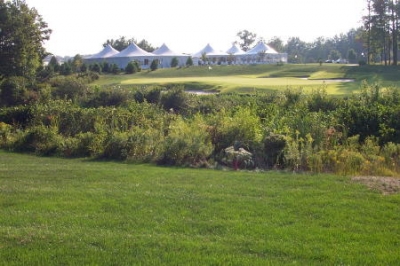 |
| You'll have to cross an environmental area one more time to reach the 18th green. |
As hinted at above, the course is challenging. Maes describes it: "Our environmental areas are probably larger than you'll see on some courses. For example, on holes seven or eighteen, you might be 150 or 160 yards to the green, which isn't a huge distance, but the wetlands go up until about 30 or 40 yards before the green, which means you have to carry it 120-30 in the air just to carry the hazard."
"Coming down the stretch there are some tough holes with some carries over the environmental areas. A lot of courses, you'll have them there, but they're an easy carry – 20, 30, 40 yards. Here, you'll have them back at the 150 mark, and you'll have to hit it 150 just to get it over the hazard," Maes added.
The difficulty is in more than just the wetlands. As mentioned before, the greens are large enough to allow you to hit them in regulation, but once you're there, you'll find very few 'gimmes.' Martz says "I really like the greens at Fawn Lake. They're large, but hardly a cakewalk. Some of them have a lot of contour, and you really have to hit the right part of the green to score well."
 |
| Looking back from the 18th green, you'll see the ecosystem that is Fawn Lake Country Club. |
As alluded to above, probably the main reason why the putting surfaces (actually, all the surfaces at Fawn Lake) are so challenging, is the conditioning. It's excellent. With such light play, the course's already durable Zoysia fairways are finer than carpet, and the greens are some of the best we've seen this season. Fast, too.
Highlights on the course include number four, a 207 yard par three. Maes describes it: "The area in front of the tee is high fescue, like you'd see on a course in England or Scotland, which gives it a dramatic look. And despite it being rated the #17 handicap hole, it's tough. The green is undulating, you have to carry a sizeable environmental area, and there's really no 'safe' place to miss. You're coming off a par five, probably feeling pretty good about yourself, and then you get to that one and make double."
Seven's probably the signature hole. 'Only' 412 yards, with a downhill tee shot, the second shot's back up a hill, carrying over wetlands to a green that seems to be perched on top of a ledge. Maes says a lot of people come up short because they'll catch either a downhill or sidehill lie on the fairway, and fail to take enough club.
On the back, the two finishing holes are classically difficult. Both involve reasonably easy drives to wide fairways. But once you're there, watch out. "One of the hardest holes in the area is seventeen, which is straight uphill and about 450 yards. You can probably only hit your drive 250, they you'll still have 200 yards left, with nearly a full carry over wetlands to a green that's well protected," Maes said.
Eighteen's a similar challenge, though the green is even tougher than seventeen's. The putting surface runs away from you from right to left, and there are two traps behind the green. The green was redone a few years ago, because if the pin was in front, the severe slope wouldn't hold approach shots. It's more playable now, but hardly less testing.
Once you're done with golf, the Fawn Lake Club experience doesn't end. There's a clubhouse with an Olympic sized pool, a yachting area for boats, a beach area with volleyball courts, a tennis club, a swim club, Tae Bo and Karate for the kids, men's and ladies locker room facilities, golf instruction, a huge practice facility, fine and casual dining, a weight room, hot tub, and finally, for those sore muscles, a masseuse.
All of this rests on the shores of Fawn Lake, though the golf course doesn't really touch it. It's a very beautiful natural setting, and the fact the golf only enhanced the environment makes it extra unique. It just goes to show, golf really can add to a natural ecosystem after all.
Details:
Fawn Lake Country Club
11305 Longstreet Drive
Spotsylvania, VA 22553
Pro Shop phone: (540) 972-3084
FAX: (540) 972-4821
Website: www.fawnlakevirginia.com
Course Designer: Arnold Palmer
Project Architect: Vicki Martz
Head Golf Professional: Patrick Fountain
General Manager: Roy Camp
Assistant Golf Professional: Chad Maes
|
Tees |
Yardage/Slope |
|
Gray |
7007/143 |
|
Blue |
6408/138 |
|
White |
5821/133/134 (ladies) |
|
Gold |
5000/120 |
Membership Information:
Memberships are available on a limited basis. Contact Francis Althese at (540) 972-6200.
| Related Links | Comments on this article? | |
|
Maryland National Golf Club Hollow Creek Golf Club Rocky Gap Resort PB Dye Golf Club in Ijamsville Whiskey Creek Golf Club |
E-mail Jeff Rendall, Editor: jrendall@golftheunitedstates.com |







